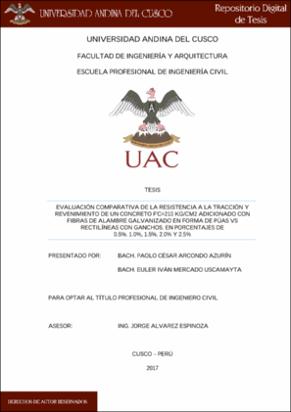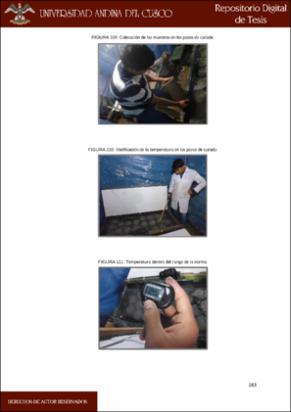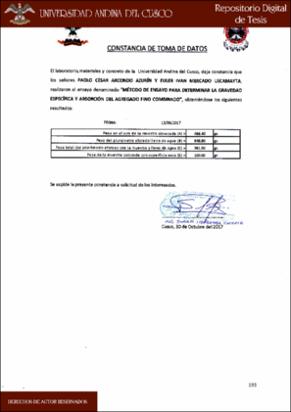| dc.contributor.advisor | Álvarez Espinoza, Jorge | |
| dc.contributor.author | Arcondo Azurín, Paolo César | |
| dc.contributor.author | Mercado Uscamayta, Euler Iván | |
| dc.date.accessioned | 2018-03-28T23:28:51Z | |
| dc.date.available | 2018-03-28T23:28:51Z | |
| dc.date.issued | 2017-12-27 | |
| dc.identifier.citation | APA | es_PE |
| dc.identifier.uri | https://hdl.handle.net/20.500.12557/1369 | |
| dc.description.abstract | El presente trabajo de investigación tiene como objetivo principal hacer un análisis comparativo de un concreto patrón f’c = 210 kg/cm 2 adicionado con fibras de alambre galvanizado en forma de púas vs otro adicionado con fibras de alambre galvanizado en forma rectilínea con ganchos, tomando como parámetros de evaluación el revenimiento y la resistencia a tracción.
Los concretos fueron elaborados con cemento Portland tipo IP, agregado fino de las canteras de Cunyac (55%) y confitillo de Vicho (45%), agregado grueso de ¾’’ de la cantera de Vicho, pues estos fueron los agregados escogidos que cumplieron con las características exigidas por las Normas Técnicas Peruanas en el Manual de Ensayos del MTC, fibras de alambre galvanizado en forma de púas y rectilíneas con ganchos fabricadas manualmente en porcentajes de 0.5%,1.0%,1.5%, 2.0% y 2.5% respecto al peso total de la mezcla patrón, el concreto fue diseñado con el método ACI (American Concrete Institute).
Se realizaron 144 muestras cilíndricas, las cuales fueron sometidas a ensayos de resistencia a compresión y tracción (ensayo brasilero – Split Test) con la inclusión de fibras de alambre galvanizado en forma de púas y rectilíneas con ganchos fabricadas manualmente en porcentajes de 0.5%,1.0%,1.5%, 2.0% y 2.5% respecto al peso total de la mezcla patrón, cantidades que se consideraron razonables para la investigación, basados en el Manual Técnico para el uso de fibras como refuerzo estructural de MACAFERRI; de la misma manera se consideró la influencia de estas fibras de alambre galvanizado en el revenimiento del concreto, estudiada a través del Cono de Abrams. Los resultados obtenidos con la inclusión de fibras de alambre galvanizado en forma de púas al 2.0% y en forma rectilínea con ganchos al 1.5% presentaron un mejor comportamiento a tracción para los 07, 14 y 28 días de curado.
En conclusión, el reemplazo con fibras de alambre galvanizado en forma de púas y rectilínea con ganchos al 2.0% y 1.5% respectivamente, en función al peso total de la mezcla patrón, dan como resultado un mejor comportamiento a tracción y también se determinó que mientras más porcentaje de fibras se agrega en ambos casos la consistencia de la mezcla tiende a volverse seca. | es_PE |
| dc.description.abstract | The main objective of this research work is to make a comparative analysis of a concrete pattern f'c = 210 kg/cm2 added with galvanized wire fibers in the form of barbed wire against another one added with galvanized wire fibers in a rectilinear form with hooks, taking as evaluation parameters the slump and tensile strength. The concretes were made with IP type Portland cement, fine aggregate from the Cunyac quarries (55%) and Vicho confitillo (45%), a coarse aggregate of ¾ “ from the Vicho quarry, as these were the chosen aggregates that fulfilled with the characteristics required by the Peruvian Technical Standards in the Manual of Tests of the MTC, galvanized wire fibers in the form of tines and rectilinear with hooks manufactured manually in percentages of 0.5%, 1.0%, 1.5%, 2.0% and 2.5% with respect to the total weight of the master mix, the concrete was designed with the ACI (American Concrete Institute) method. 144 cylindrical samples were made, which were subjected to tests of resistance to compression and traction (Brazilian test - Split Test) with the inclusion of galvanized wire fibers in the form of barbs and rectilinear with hooks manufactured manually in percentages of 0.5%, 1.0 %, 1.5%, 2.0% and 2.5% regarding the total weight of the master mix, quantities that were considered reasonable for the research, based on the Technical Manual for the use of fibers as a structural reinforcement of MACAFERRI; In the same way, the influence of these galvanized wire fibers on the slump of concrete, studied through the Cone de Abrams, was considered. The results obtained with the inclusion of galvanized wire fibers in the form of barbs at 2.0% and in a rectilinear form with hooks at 1.5% showed a better tensile behavior for the 07, 14 and 28 days of curing. In conclusion, the replacement with galvanized wire fibers in the form of barbs and rectilinear with hooks at 2.0% and 1.5% respectively, depending on the total weight of the master mix, result in a better tensile behavior and it was also determined that while more percentage of fibers is added in both cases the consistency of the mixture tends to become dry. | en_US |
| dc.description.uri | Tesis | es_PE |
| dc.format | application/pdf | es_PE |
| dc.language.iso | spa | es_PE |
| dc.publisher | Universidad Andina del Cusco | es_PE |
| dc.rights | info:eu-repo/semantics/openAccess | es_PE |
| dc.rights.uri | https://creativecommons.org/licenses/by-nc-nd/2.5/pe/ | es_PE |
| dc.source | Universidad Andina del Cusco | es_PE |
| dc.source | Repositorio Institucional - UAC | es_PE |
| dc.subject | Fibras-Alambre | es_PE |
| dc.subject | Análisis comparado | es_PE |
| dc.subject | Resistencia-Tracción | es_PE |
| dc.subject | Alambre galvanizado | es_PE |
| dc.title | Evaluación comparativa de la resistencia a la tracción y revenimiento de un concreto F`C=210 KG/CM2 adicionado con fibras de alambre galvanizado en forma de púas Vs rectilíneas con ganchos, en porcentajes de 0.5%, 1.0%, 1.5%, 2.0% y 2.5% | es_PE |
| dc.type | info:eu-repo/semantics/bachelorThesis | es_PE |
| thesis.degree.name | Ingeniero Civil | es_PE |
| thesis.degree.grantor | Universidad Andina del Cusco. Facultad de Ingeniería y Arquitectura | es_PE |
| thesis.degree.level | Titulo Profesional | es_PE |
| thesis.degree.discipline | Ingeniería Civil | es_PE |




